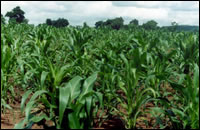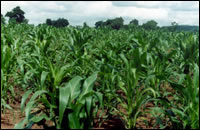Can Uganda Feed Starving Populations in Eastern Africa?

 |
| Maize: one of Uganda's major exports |
There is no doubt that Uganda stands high comparative advantage in Agricultural production and has the potential to become East Africa’s biggest food basket during this difficulty. The country produces a wide range of foodstuffs including root crops, grains and legumes, fruits, vegetables and spices. This wide range of production is made possible by a favourable seasoned climate with a temperature range of 15-30oC, annual rainfall of 750-2000 mm, and fertile soils. Whats more, agriculture is the backbone of the country and employs a larger proportion (close to 70%) of the population. Besides, there is minimal requirement for irrigation.
The volume of unrecorded agricultural exports leaving Uganda's borders into her five neighbouring states has confirmed the country as a major food basket for the region. Recent findings by the Central Bank, the Uganda Bureau of Statistics (UBOS) and the Uganda Revenue Authority (URA) indicate that Uganda overrides the rest of East Africa in Agricultural productivity. Presenting the findings of the survey conducted between 2005 and 2006, David Kihangire, the director of research at the Bank of Uganda said informal trade between Uganda and her five neighbours has significantly increased involving huge transactions of both agricultural and industrial products.
Results of the survey showed that Uganda's overall export earnings from both trading arrangements (formal and informal trade) amounted to $1.19 billion in 2006 compared to the combined export earnings of $1.01 billion in 2005.The survey involved monitoring trade over five months at the 14 main border posts with Kenya, Tanzania, Rwanda, DR Congo and Sudan. The survey found that agricultural products accounted for 48.7% of the economy. The leading agricultural exports were maize and beans, whose values were estimated at $5.8 million (30,288 tonnes) and $0.8 million (1,849 tonnes) respectively. Others were Irish potatoes, fruits, sweet potatoes, cassava, beans, bananas and groundnuts.
Even with the above statistics, there are many faces to the rising food prices in Uganda. It is undeniable that a large number of Ugandans are going hungry, as produce rots in farmer’s gardens in other parts of the country. Moreso, food prices at the farms are painfully low as farmers who cannot afford transportation to better markets are manipulated by middle men, who buy their produce at meager prices. As farmers sell their farm produce at low costs, the prices of other basic commodities like soap, salt, cooking oil and paraffin remain high and unaffordable. When a farmer from Lango or Acholi, high simsim producing areas sells his one kg of sesame at 500 Uganda shillings less than a dollar but has to buy a kg of sugar at 1500Ugshs, a tablet of soap at Ug Shs 500 and paraffin at Ug Shs 2000 a liter, it is difficult to see how the soaring prices will benefit such a farmer. In any case, how will that farmer meet other basic needs like health and education?
The soaring food prices can become a golden opportunity for farmers in Uganda if the government and members of the private sector recognised that deliberate efforts are required to increase productivity. Emphasis should be made on long term perspectives, plans and strategies, aimed at enhancing agricultural productivity for Uganda to increase and sustain production for the region and the rest of the world.
Players in government and the private sector ought to embark on a deliberate scientific research agenda aimed at informing farmers on improved agricultural seed strains that are easier to manage and can mature in short periods. Study on climatic variations and soils should be made in different parts of the country and proper recommendations made to farmers, so as to reduce incidences of farmers blindly focusing on production of crops that otherwise do not yield in their different regions.
A policy to make farmers graduate from archaic rudimentary agriculture to modern farming methods would also go a long way. Emphasis should be made on expanded tillage and use of pesticides and fertilisers. Within the government’s current “Bonna Bagagawale” or “prosperity for all” project, a special section should be deliberately directed towards supporting farmers. Farmers should form groups and use group efforts to acquire some of the more expensive farm machinery.Group purchase lowers the cost to an individual. The presence of farmer federations like the Uganda National Farmers Association (UNFA) should naturally be an advantage in supervising farmers to this effect. Such institutions should receive high support and publicity from the government and other citizens of the country.
Finally, the road network especially in the rural parts of the country has literally collapsed. Thus, while a bunch of bananas costs between Ug Shs 1,000 and Ug Shs1,500 in some rural markets in Masaka and some parts of Western Uganda, that same bunch goes for between Ug Shs 8,000 and 15,000 in Kampala.
If roads were better and farmers had the opportunity to transport their farm produce at reduced costs, Both farmers and consumers would benefit. Therefore, infrastructural development and expanded transport facilities are also issues that the government should deal with before justifying the current soaring prices as a benefit to any Ugandan farmer.
